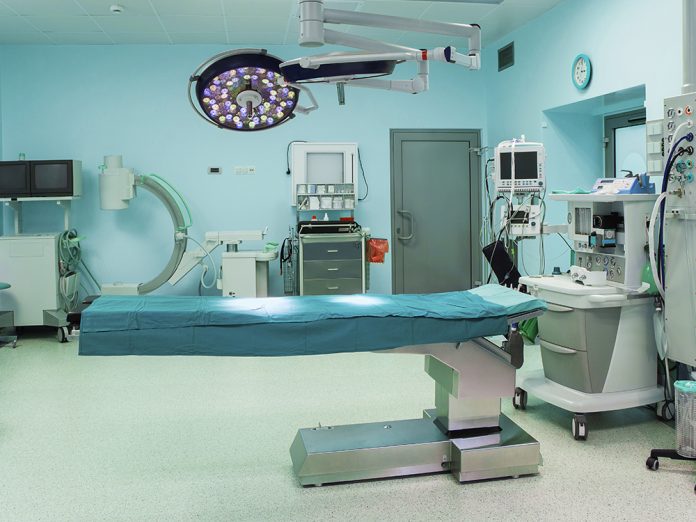The operating room is the place where operations are performed in a sterile environment in the hospital, and there are many operating rooms (operating theater) in it.
Operating Rooms (Halls); They are large, easy-to-clean, well-lit rooms. It has no windows or is confined to a wall if any. Humidity and room temperature are controlled by the ventilation system.
Operating Room Equipment
The main equipment of the operating rooms is the operating table and the anesthesia device. In addition, there are tables for sterile surgical instruments used during surgery, cabinets, and tables for common surgical materials used. There are special sinks for pre-operative surgical handwashing just at the entrance of the operating room. They are usually equipped with taps that can be opened and closed with a sensor or with afoot. Hands are washed with special antiseptic soaps.
Operating Table: It usually stands in the middle of the room. The height of the table is adjustable (down-up), it can be rotated (right-left), it can be bent at the hip, waist, and neck. The table can be tilted with the feet up (Trendelenburg, head down) or down (reverse Trendelenburg, head up). The parts under the legs of the operating table are removed, and special footrests are attached, and the patient can be placed in a gynecological position (lithotomy position, also called birth position). Today, direct radiography and scope can be performed on many operating tables.
Head Lamps: These are powerful lamps designed in such a way that shadows do not form in the surgical field. To achieve this, it consists of many lamps placed in a large circle and all focus on a single point. In General Surgery Instruments, a sterile handle is attached to the middle of the lamp so that the operators can adjust the light themselves. The operating lamp can be moved (pulled) in all directions in the horizontal and vertical plane, tilted right-left, forward-backward (in all directions).
Anesthesia Device: It is kept at the head of the operating table. This device allows the patient to breathe during the surgery; anesthetic gases and oxygen are given to the patient with this device. It has the tubing connected to the patient and built-in monitors that help control the gas mixture in the breathing circuit.
The anesthesia device has a special monitor (screen). In this monitor, the following appears and is followed.
ECG: Continuous ECG monitoring is performed with probes attached to the patient’s chest and shoulders. Heart rate (pulse) is also tracked in this way.
Patient’s instantaneous respiratory rate
Oxygen Saturation: It is measured with a fingertip pulse oximeter.
Blood Pressure (Blood pressure): The cuff of the automatic sphygmomanometer, which can be started manually and with time adjustment, is connected to the right or left arm.
Immediate Arterial Pressure: If an arterial (intra-arterial) catheter is inserted, the monitor’s blood pressure is momentarily monitored (usually inserted into the radial artery).
Anesthesia Trolley: It is right next to the anesthesia device, or it is attached to the anesthesia device. It contains medications and equipment that the anesthesiologist may need.
Features of the Operating Room
Dimensions: Although it can change according to the requirement, the recommended size is 6.5 m x 6.5 m x 3.5 m. If there is a glass window, it can only be planned on one side.
Doors: The width of the main door should be a minimum of 1.2 – 1.5 m. Swing doors can be used, but automatic sliding doors are preferred. Fasteners and other parts on the door must be stainless steel.
Floor Covering and Walls: The floor must be non-slip, durable (against chemicals and disinfection), and contain minimal attachments. Walls: laminated polyester or a smooth non-glare paint can be used. Tiles may break, and epoxy paint may flake off and should not be used. Corners and edges should be covered with steel or aluminum borders, or the floor covering should be curved so that it does not corner against the wall.
Ventilation: Ventilation is applied in a so-called laminar flow. Here, fresh filtered air is constantly supplied to the operating room, and constant positive pressure is created in the room (minimum 5 cm H2O) so that the airflow constantly flows from the inside of the room to the outside. This minimizes airborne contamination. The air in the operating room should be changed 20-30 times per hour, and at least 90% of 0.5-micron particles should be filtered. The humidity of the operating room should be between 40-60%, and the temperature should be 20o-24o C. The temperature of the operating room should be adjusted according to the patient, not the personnel (child, newborn, elderly, burn patient, etc.).
Electrical System: It is connected to the uninterrupted power supply (battery) and generator system. Each operating room has an aspirator system and an oxygen system.








